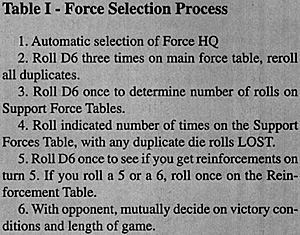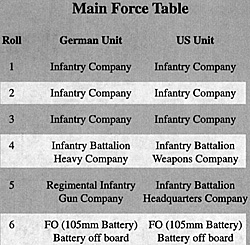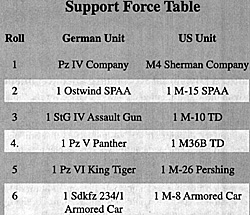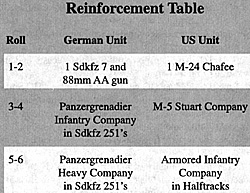 It never fails; just as your gaming group gets into a good
campaign, the holidays come around and people become just
too busy to meet together as a group and "push micro". Last
Christmas I found myself with a busy traveling schedule all over
Utah and Florida. I was going to spend some time in Florida with
my brother, who told me he was interested in gaming. Ah, if
only I could pack along big boxes of scenery and trays of Soviet
WWII hordes and German panzers, I had been working on a pet
project to play a new rules set for Ancients, though, and I
packed them and a few scenery items into a small cigar box and
flew off. I had a very enjoyable time, and played quite a few
games.
It never fails; just as your gaming group gets into a good
campaign, the holidays come around and people become just
too busy to meet together as a group and "push micro". Last
Christmas I found myself with a busy traveling schedule all over
Utah and Florida. I was going to spend some time in Florida with
my brother, who told me he was interested in gaming. Ah, if
only I could pack along big boxes of scenery and trays of Soviet
WWII hordes and German panzers, I had been working on a pet
project to play a new rules set for Ancients, though, and I
packed them and a few scenery items into a small cigar box and
flew off. I had a very enjoyable time, and played quite a few
games.
However, I discovered a few drawbacks to my "travel" set, First the miniatures got needlessly banged about (but thankfully not damaged. Second, with ancients you just have to live without the imaginary clanking of yank treads, mortar pops, and machine gun staccato. Not to mention missing all of those great quotes and accents from WWII movies that make up parts of entertaining conversations during play. (How do you do a Carthaginian or Roman accent?) Putting some thought and effort into R&D, I came up with a new form of miniature gaming for me, which title I have placed on this article.
 Before leaving for the holidays, I had purchased a
number of tin cookie boxes (the contents of which were
devoured at the office). These were just the right size for what I
had in mind: they were small (about 6"x9"x3", sturdy, and very
decorative, and completely metallic.
Before leaving for the holidays, I had purchased a
number of tin cookie boxes (the contents of which were
devoured at the office). These were just the right size for what I
had in mind: they were small (about 6"x9"x3", sturdy, and very
decorative, and completely metallic.
I have modelled predominantly WWII Eastern Front, but I enjoy dabbling in Western Front Campaigns (see my previous article "Modular Bulge" - CPQ-7). I put together some 1/285 units and reviewed what I had in terrain. I built the models on stands attached to magnetic strips, and found that the lighter items and infantry would stay attached to the box lid, and so I developed an idea of the size of the forces I could put in the box bottom and the top. A pad of felt was placed between them so any items that fell off the top would land softly.
I put together US and German units that would be found
on the western front from late 1944 to 1945. I had already begun
working on winterized units (see my last article); these would be
fall and spring paint schemes.
 I decided the forces would be
predominantly US Infantry and German Volksgrenadiers with
various armored units for diversity, and set up a random force
generator so that each game would be different and challenging.
The selection procedures and charts are in table 1. Victory
conditions would be determined mutually between the players.
I decided the forces would be
predominantly US Infantry and German Volksgrenadiers with
various armored units for diversity, and set up a random force
generator so that each game would be different and challenging.
The selection procedures and charts are in table 1. Victory
conditions would be determined mutually between the players.
The next step was scenery. I purchased a small plastic shoe
bin from a discount store that would hold ALL the scenery, dice, and a
measuring tape. I cut a green cloth about 2'x3'. This would be fine for
forested, hilly terrain where ranges were short and actions swift.
Smaller blob-shaped darker green felt delineates forest areas, on which
I place random clumps of micro trees and lichen. I have a number of
small irregular styrofoam hills and ridges that I put in, and a few
wiggly strips of dark blue for rivers and streams. I am constructing a
small Belgian town and bridge, and also cut the various roads from
cloth.
 There. All done. Just a Tin Box, plastic shoe bin, my copy of
CD2, and it all fits with room left over in my carry-on bag. I can travel
anywhere and order my Shermans and armored infantry to capture a
bridge from demoralized Volksgrenadiers, or counter attack green US
infantry with SS troops riding a King Tiger. Now if I can only find
room to play it on a Boeing jet.
There. All done. Just a Tin Box, plastic shoe bin, my copy of
CD2, and it all fits with room left over in my carry-on bag. I can travel
anywhere and order my Shermans and armored infantry to capture a
bridge from demoralized Volksgrenadiers, or counter attack green US
infantry with SS troops riding a King Tiger. Now if I can only find
room to play it on a Boeing jet.
A note of warning though: these little tin boxes give you lots of ideas. Not only do I have travel sets for ancients and WWII, there are projects on my workbench developing for Harpooon Modern Naval Combat, WWI dreadnoughts, 5mm FrancoPrussians, and oh yes, that neat little set of 5mm Over The Top forces and trenches ... this is a great way to dabble in different theaters of WWII.
Back to Table of Contents -- Command Post Quarterly # 13
To Command Post Quarterly List of Issues
To MagWeb Master Magazine List
© Copyright 1997 by Greg Novak.
This article appears in MagWeb.com (Magazine Web) on the Internet World Wide Web.
Other articles from military history and related magazines are available at http://www.magweb.com
